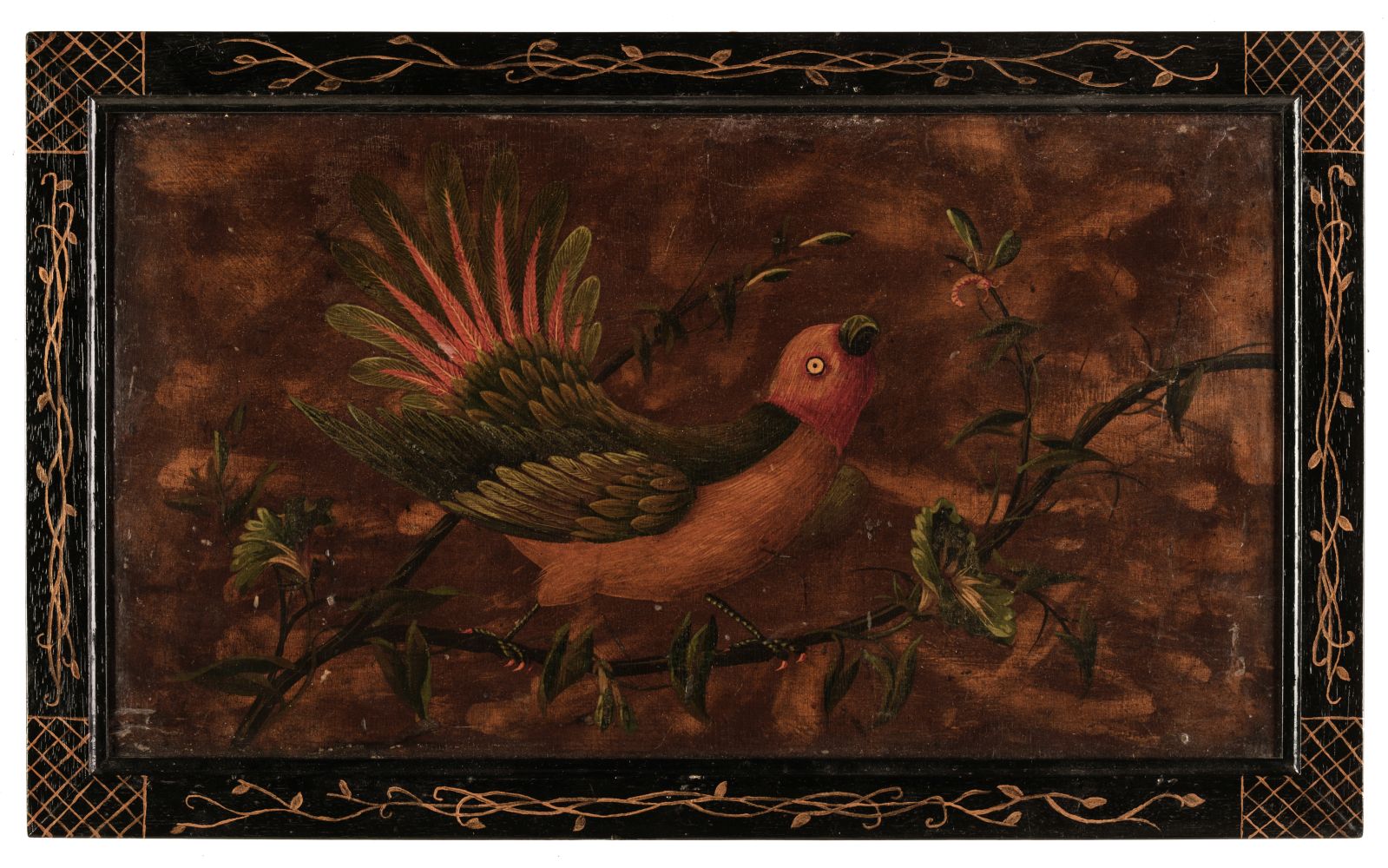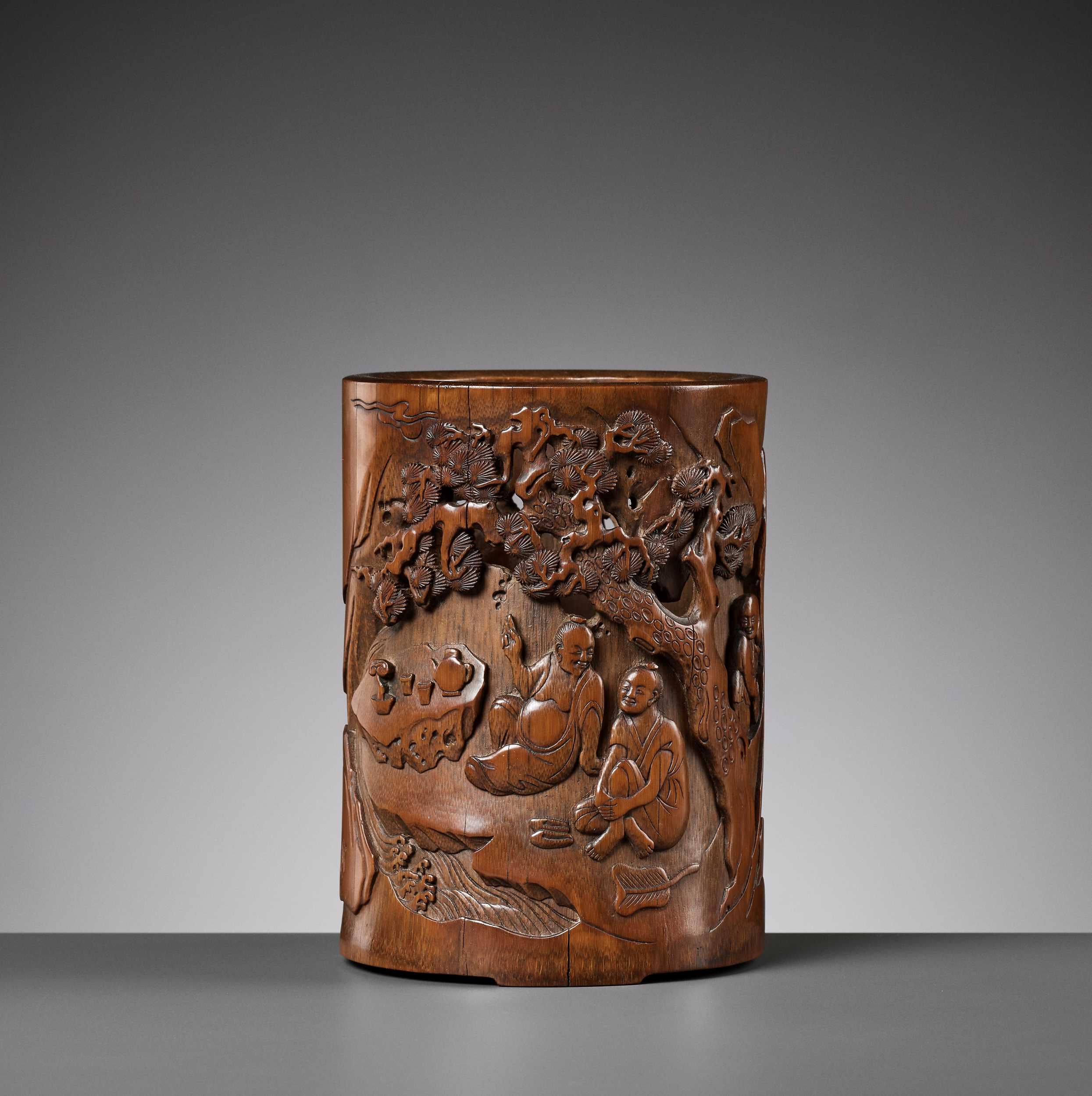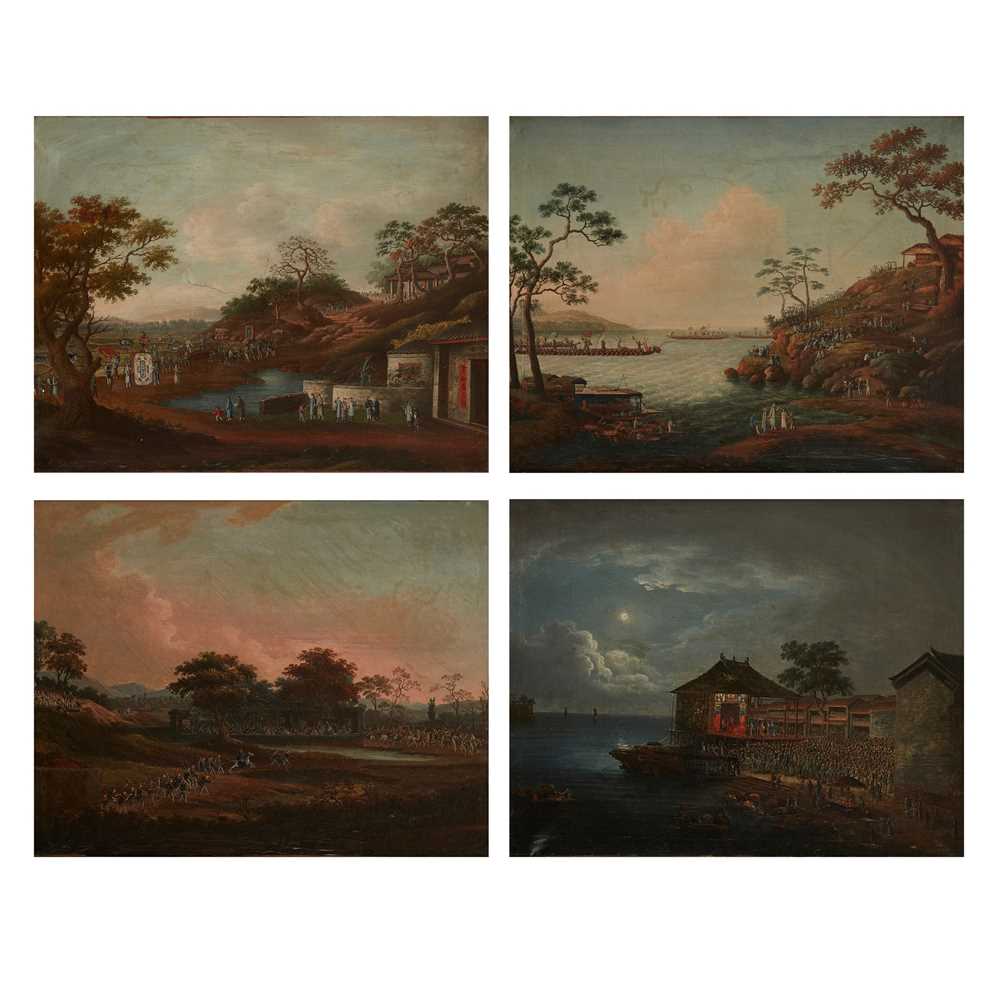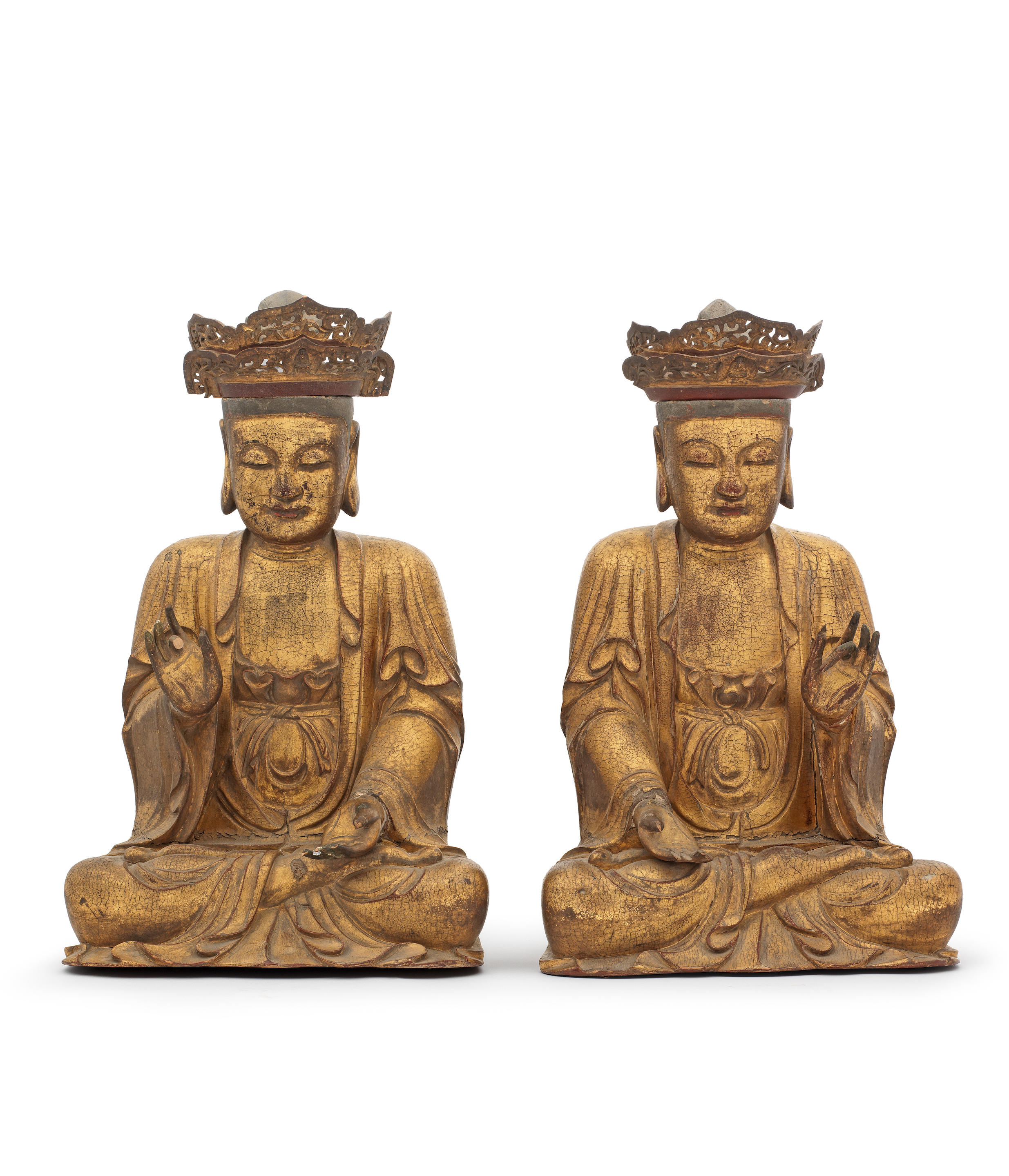CHINESE SCHOOL, MID 18TH-CENTURY A MAGNIFICENT AND EXTREMELY UNUSUAL CONCERTINA ALBUM OF CHINESE WATERCOLOURS OF 50 MARINE ANIMALS AND MONSTERS on 22 sheets of vellum, and TWO FINE ALLEGORICAL FRONTISPIECES, watercolour on vellum, each approximately 326 x 208mm, [Quianlong Period, mid 18th century], the watercolours, with whitened backgrounds, mounted back-to-back within borders of silvered embossed paper on composite boards, each pair of watercolours (front and back) joined along longer edges to form a double-sided concertina, each side forming its own series with a frontispiece and 11 watercolours, covers elaboratly tooled in panels on silvered embossed paper, edges silvered (one watercolour and its border detached, a few small areas rubbed occasionally affecting an image, covers and edges oxidised, extremities rubbed, a few small areas of loss to edges of covers and borders), in a late 19th-century French marbled-paper box. Provenance : APPARENTLY REMOVED FROM THE YEN-MIN-UYEN OR SUMMER PALACE in October 1860, by a soldier of the Anglo-French expedition of 1860 (lengthy inscription in French in a mid 19th-century French hand, on the underside of the lid of the box). The two frontispieces are most likely after European models, one showing Neptune riding ashore triumphant in chariot and clutching his trident, the other a contest between man and crocodiles over the future of some sheep that have strayed too close to the waters edge. The 50 beasts are after European protypes, all but eight of which have been identified. The original woodcuts or engravings from which the artist made his copies appeared in the following works: Gerner, Conrad (1516-1564). Nomenclata Aquatium Animatium ; Belon, Pierre (1517-1564). L'Histoire naturelle des estranges poissons . 1551; Rondelet, Gulielmus (1507-1566). Libri de piscibus marinis . Lyons: 1554-5; Aldrovandi, Ulisse (1522-1605). De piscibus libri V et de cetis lib. unus. Bologna, 1613; Jonston, John (1603-1675). Historiae Naturalis . Frankfurt: 1650-63; and Jonston, John. Theatrum Universale Omnium Animalium . Amsterdam: 1718. These mythical marine monsters were no doubt selected as subjects for their astonishing and fabulous appearances; the artist being inspired by some of European science's more fantastical images. The artist uses a distinctive pointillist technique reminiscent of work produced in China for export, yet here the palette is both intriguing and unusual: whereas the two frontispieces show the systematic use of three shades of green and hues of blue and pink typical of chinese work, the beasts are depicted in a broader range of colours. The unusual and highly decorative borders and binding are worked in a series geometric designs made up from three simple tools - a square 'spiral', a flower, and a seven-lined square - suggestive of early 19th-century Chinese work. The composite boards are composed of layers of mulberry paper and silk glued back to back and hinged along the longer edges. This album is particularly fine in having watercolours on both sides and the arrangement of one frontispiece followed by 11 images, for each side, makes it clear that this was a consciously planned project. The choice of vellum as the support medium is also significant. Whilst it may be generally said that the Chinese had a natural prediliction for their high quality native materials, namely silk and paper, the Quianlong period is noted for the variety of media used and the willingness of its artists to experiments with different and often new materials. This is album is, therefore, an extremely rare example of such work. The combination of European models for the fish, and certainly for one of the frontispieces, the particular arrangement of the album, and the elaborate binding, suggest possible European involvement in the project. Much is now known about the working practices of the Chinese export market - a market which was used to copying European models - but it is only recent resea
CHINESE SCHOOL, MID 18TH-CENTURY A MAGNIFICENT AND EXTREMELY UNUSUAL CONCERTINA ALBUM OF CHINESE WATERCOLOURS OF 50 MARINE ANIMALS AND MONSTERS on 22 sheets of vellum, and TWO FINE ALLEGORICAL FRONTISPIECES, watercolour on vellum, each approximately 326 x 208mm, [Quianlong Period, mid 18th century], the watercolours, with whitened backgrounds, mounted back-to-back within borders of silvered embossed paper on composite boards, each pair of watercolours (front and back) joined along longer edges to form a double-sided concertina, each side forming its own series with a frontispiece and 11 watercolours, covers elaboratly tooled in panels on silvered embossed paper, edges silvered (one watercolour and its border detached, a few small areas rubbed occasionally affecting an image, covers and edges oxidised, extremities rubbed, a few small areas of loss to edges of covers and borders), in a late 19th-century French marbled-paper box. Provenance : APPARENTLY REMOVED FROM THE YEN-MIN-UYEN OR SUMMER PALACE in October 1860, by a soldier of the Anglo-French expedition of 1860 (lengthy inscription in French in a mid 19th-century French hand, on the underside of the lid of the box). The two frontispieces are most likely after European models, one showing Neptune riding ashore triumphant in chariot and clutching his trident, the other a contest between man and crocodiles over the future of some sheep that have strayed too close to the waters edge. The 50 beasts are after European protypes, all but eight of which have been identified. The original woodcuts or engravings from which the artist made his copies appeared in the following works: Gerner, Conrad (1516-1564). Nomenclata Aquatium Animatium ; Belon, Pierre (1517-1564). L'Histoire naturelle des estranges poissons . 1551; Rondelet, Gulielmus (1507-1566). Libri de piscibus marinis . Lyons: 1554-5; Aldrovandi, Ulisse (1522-1605). De piscibus libri V et de cetis lib. unus. Bologna, 1613; Jonston, John (1603-1675). Historiae Naturalis . Frankfurt: 1650-63; and Jonston, John. Theatrum Universale Omnium Animalium . Amsterdam: 1718. These mythical marine monsters were no doubt selected as subjects for their astonishing and fabulous appearances; the artist being inspired by some of European science's more fantastical images. The artist uses a distinctive pointillist technique reminiscent of work produced in China for export, yet here the palette is both intriguing and unusual: whereas the two frontispieces show the systematic use of three shades of green and hues of blue and pink typical of chinese work, the beasts are depicted in a broader range of colours. The unusual and highly decorative borders and binding are worked in a series geometric designs made up from three simple tools - a square 'spiral', a flower, and a seven-lined square - suggestive of early 19th-century Chinese work. The composite boards are composed of layers of mulberry paper and silk glued back to back and hinged along the longer edges. This album is particularly fine in having watercolours on both sides and the arrangement of one frontispiece followed by 11 images, for each side, makes it clear that this was a consciously planned project. The choice of vellum as the support medium is also significant. Whilst it may be generally said that the Chinese had a natural prediliction for their high quality native materials, namely silk and paper, the Quianlong period is noted for the variety of media used and the willingness of its artists to experiments with different and often new materials. This is album is, therefore, an extremely rare example of such work. The combination of European models for the fish, and certainly for one of the frontispieces, the particular arrangement of the album, and the elaborate binding, suggest possible European involvement in the project. Much is now known about the working practices of the Chinese export market - a market which was used to copying European models - but it is only recent resea















Testen Sie LotSearch und seine Premium-Features 7 Tage - ohne Kosten!
Lassen Sie sich automatisch über neue Objekte in kommenden Auktionen benachrichtigen.
Suchauftrag anlegen